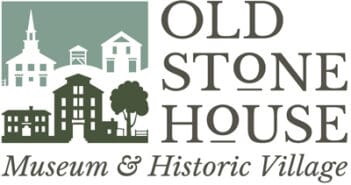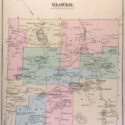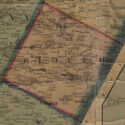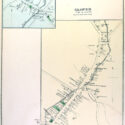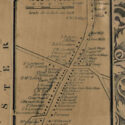Town History
From the Vermont Historical Gazetteer, edited by Abby Maria Hemenway. Orleans County – Glover Chapter: By Rev. Sidney K. B. Perkins. Published by Claremont Manufacturing Co, 1877. Pgs 200, 203-205.
Incidents of Interest in Glover:
1810– An event occurred which led to the settlement of the north-eastern part of Glover. There was a pond about 5 miles from what is now called Glover Village, which was a mile and a half long and half a mile wide, and which discharged its waters to the south, forming one of the head branches of the river Lamoille. Its northern shore consisted of a narrow belt of sand and a bank of light sandy earth; here had been formed a deposit spoken of as resembling frozen gravel, 2 or 3 inches in thickness and extending into the pond for 5 or 6 rods from the northern shore. This deposit formed the only solid barrier* to the waters, preventing them from descending into Mud pond which was a little distance off in a northerly direction.
(*This barrier was no doubt the work of an ancient glacier, or one of the results of the drifts, the marks of which, are everywhere traced. The sand of which it was composed is similar to that found on the banks of large rivers flowing through granite regions, called “River sand.”
In both Long pond and Mud pond were large quantities of peat or muck which became mingled with the soil and sand deposited along the course of the flood, in many places greatly benefitting the soil, though at first it was supposed the meadows were ruined. No better meadows are anywhere found, than these have proved under cultivation.
June 6, 1860, half a century after the event, the Orleans County Historical Society appointed a special meeting at Glover, to celebrate the event, and several of the men who were engaged with others, in draining Long pond, 50 years before, were present to hear the account of the event, prepared by Rev. Pliny H. White. The meeting was one of great interest and will long be remembered by those who were present. – S. R. Hall)
From Mud pond flowed a small stream on which were built several grist and saw-mills. This was sometimes in a dry season insufficient to carry the mills to the satisfaction of those who wished them used for their benefit. Therefore it was proposed to cut a channel from the larger pond to the smaller, and thus increase the stream. On the 6th of June quite a company of persons assembled on the northern bank of the pond and proceeded to accomplish this object. To the surprise of the workmen the water did not follow the channel they had dug, but descended into the sand beneath.
It appears that they had not observed that there was beneath the gravel or hard pan, a species of quicksand. In a short time so much sand was carried away, thereby weakening the hard pan, that the pressure of the water widened the channel into a deep gulf, down which the waters rushed to the other pond. The workmen had to hurry away to save their lives, as they were in danger of being swallowed up in the raging torrent. In a few moments the whole pond had disappeared from its bed. Rushing down the Mud pond, tearing away part of its barrier and gaining additional strength from its tributary waters, prostrating the mill of Mr. Aaron Wilson, the torrent swept down the channel of the Barton river, and made rapid descent on the meadow lands of Barton; thence to Lake Memphremagog. Through all this distance it tore up the forest trees and bore them onward, while huge stones were removed from their places and carried a considerable distance, even after a course of 17 miles, a large rock, estimated at a hundred tons weight, was moved several rods from its bed. It was a grand and majestic sight on its way, sometimes 60 feet high and 20 rods wide, boiling and raging as it moved along. Some people who could hear the noise made by the torrent, but could not see the cause, imagined that the day of judgment was close at hand.
1811– Glover did not escape a visit from the spotted fever, which appeared first in Medfield, Mass., in March 1806, and a year later in the Connecticut valley and along the Hoosic and Green Mountain ranges, and was most fatal in the years 1812 and ’13. It appeared in Glover during 1811, much to the alarm of people. Of the small number of inhabitants in town then, 20 died of this disease.
1815– On the first day of January, an accident occurred in the family of John Crane, Esq., worthy of notice. As it was the custom in those days to take ardent spirits of some kind before eating, Esq. Crane, having a number of men at work for him, gave them as much as they wished and set what remained on the shelf. A little daughter of his, about 5 years old, reached up and took the vessel containing the spirit and drank from it. Some of the family spoke to her and she stepped back, but soon fell down and died in short time. Her grave was the first one made in the east burying-ground. Esq. Crane, when the temperance cause was started in Vermont, became one of the first and firmest advocates of total abstinence.
1816– June 7th, 8th and 9th, the growing crops were covered with snow. As a consequence of the cold and snow, the leaves on the trees were killed, but new ones afterwards started out. The birds perished from the cold, by hundreds. The harvest was so light that corn rose in price, from $1.00 to $2.00 per bushel, and wheat from $1.00 to about $3.00 per bushel.
1834, May 18th- A brilliant aerolite, giving a light more intense than that of the sun, was seen about 3 o’clock A. M., in a northerly direction. It descended rapidly in an easterly direction. In a few moments a shock ensued like that of an earthquake, shaking windows, the ware in houses, &c. with considerable violence.
1843– Glover suffered severely from the prevalence of the erysipelas. A large portion of the people were called to watch with the sick or dying. Few circles of friends escaped bereavement, and the new-made graves numbered about 20. Dr. Sandforth Atherton died a martyr to his faithfulness as an attending physician.
1847– March town meeting. This will be long remembered as the smallest in number of voters present, known for many years. It was so on account of a severe snow storm attended with high winds which blocked up the roads with deep snow-banks, rendering travel almost impossible. There were at Glover town meeting about 30 individuals.
Orleans Liberal Institute
Messrs. Rev. T. J. Tenney, H. S. Bickford, H. McLellan, C. Bemis, J. Crance, C. C. Hardy, J. M. Smith, and L. Dennison, together with their associates and successors, were declared a body corporate Nov. 5, 1852, under the aforementioned name.
The first principal was Perkins Bass, who remained one year; the second, Isaac A. Parker, who remained 6 years. During this time the school was well supplied with charts, maps, globes, specimens and philosophical and astronomical apparatus. In 1857-’58 (Mr. Parker’s last year), the aggregate of attendance, the 3 terms, was 193.
The Institute was next under the charge of Geo. W. Todd, Esq. By this time academies had increased from 3 when this school was founded to 9 in Orleans County, besides several high schools; yet in 1865, the number of pupils was but slightly diminished.
The fourth principal was Mr. A. C. Burbank, afterwards a teacher of the freedmen in Virginia. The present principal (1867) is Mr. E. W. Clark, who has secured the esteem and patronage of the public to a good degree. The academy building, which belongs to the Institute and to district No. 3, unitedly [sic], has recently been put in thorough repair.
The officers of the Institute are of the denomination of Universalists, but have ever welcomed to the school those of any religious faith, and given to them the fullest scope of religious belief, without question, persecution or hindrance.
The Academy has existed long enough to send forth men and women, both honorable as citizens and as teachers, and who are highly esteemed wherever they have found a home. There have been 2 lyceums or debating clubs, maintained during the past 20 years, one at Glover Village and the other in the west part of the town. A library of general reading was established in 1855, and is now in good condition.
Town Facts:
- Charter granted: 1783, to Gen. John Glover and his associates
- Gen. Glover (1732-1797) of Marblehead, Mass., received grant in 1781 for military service.
- First settlers: James Vance and Ralph Parker, 1798
- First town meeting: 1802
- West Glover was incorporated as a village soon after 1900. Glover village was incorporated in 1905. Both merged with the town of Glover in 1973.
- Runaway Pond” incident of June 6, 1810: Washout drained a small lake known as Long Pond. Stories vary as to what human activity caused it.
- Nathan Cutler’s sawmill, 1804, was the first industrial site in town. John Boardman built the first gristmill, fulling and dressing mill, tannery and shoemaking shop next to it. There have been at least three other gristmills in Glover, and another tannery was established in the 1830s. There was a starch mill, bobbin mill, and lime kiln in West Glover at the same time.
- Timothy Lyman built a brick kiln in 1806.
- Potash was a major industry in Glover, beginning with Ralph Parker’s “ashery,” ca. 1799. Chester S. Phillips, gunsmith, began one of the first and most widely known taxidermy shops in New England in 1840.
- There were more sheep than cattle in Glover until around 1870.
- Meadow Brook Creamery opened in 1889 in West Glover. The building became the town garage by 1983. Hops was a major crop on some farms from 1860 to 1885.
- The production of cedar oil, used in furniture polish among other things, was a source of supplemental income for the town
